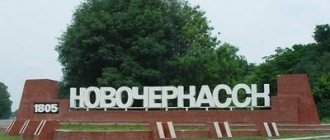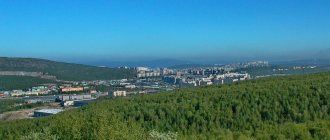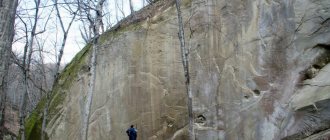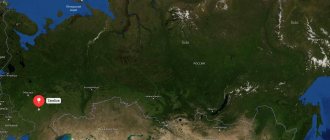Pyatigorsk is one of the oldest resort cities in the North Caucasus. It is located between the peaks of several mountains, the highest mountain being Beshtau. The area of the city is 97 km2, it rises 500 m above sea level.
The map of Pyatigorskaya from a satellite allows you to view in detail the 2nd largest city in the Stavropol Territory by number of inhabitants. About 140 thousand people live in the city itself, and another 60 thousand occupy the outskirts and nearby villages.
The Podsumok River flows along the western, northwestern and northern outskirts of the city. As can be seen on the map of Pyatigorsk by district, this winding mountain river is not the only body of water in the resort city. In the central and eastern part of Pyatigorsk there are many mineral springs, for which tourists and vacationers come to the city.
Pyatigorsk municipality consists of 7 villages. You can see the structure of the city on a map of Pyatigorsk with diagrams. The main attractions can be found in the northern and central regions of the agglomeration.
Where is Pyatigorsk?
Pyatigorsk is a resort town in the Stavropol region of Russia, which is the administrative center of the municipality of the resort town of Pyatigorsk.
It is located on the Mineralovodsk foothill plain. The city is located on the right and left banks of the Podkumok River. Within the city limits there is Mount Mashuk, whose height is 993 m above sea level. It is considered the center of the North Caucasus Federal District. The approximate population is 146 thousand people, the total area of Pyatigorsk is 97 square kilometers. The climate in Pyatigorsk is characterized by mild winters and hot summers with low relative humidity. In winter, frequent changes in atmospheric pressure are observed. The annual precipitation rate is 518 mm.
Pyatigorsk is located in the same time zone as Moscow, the offset relative to Coordinated Universal Time (UTC) is +3.
Economy and industry of Pyatigorsk
The economic component is based on the resort specifics of the city. Several industrial enterprises, as Yandex maps of Pyatigorsk show, are located on the western outskirts and do not interfere with local residents and tourists enjoying the beautiful city. Food industry enterprises produce bread, milk, ice cream, meat, and bottle mineral water. Also in the city they sew fur coats, outer and underwear, and sew shoes.
The service sector and trade are well developed in Pyatigorsk. Some shopping centers are open 24 hours a day, and on the streets of the city you can always easily find a hairdresser, restaurant or entertainment center.
There are 22 sanatoriums in the city, which are always filled with vacationers. And in terms of the level of provision of tourist services, Pyatigorsk can easily compete with large Russian and European resorts.
Pyatigorsk Airport
Pyatigorsk does not have its own airport. The nearest airfield is in the city of Mineralnye Vody. The distance from the center of Pyatigorsk to the airport is 23 km. The airport has the status of a federal facility and is the largest airfield in the Stavropol Territory and the North Caucasus Federal District. Airfield type: civil. Operating hours: 24 hours a day.
The airport provides servicing for aircraft of major Russian airlines: Pobeda, Aeroflot, UTair, Yakutia, and Ural Airlines. Popular destinations of regular and charter flights: Moscow, Rostov-on-Don, Yekaterinburg, Chelyabinsk. Annual passenger traffic is more than 2.4 million people.
Map of Pyatigorsk with streets
Pyatigorsk districts and villages are connected by large and small streets. A railway track runs through the western outskirts of the city and enters the center. If you look at a map of Pyatigorsk with streets, you can find the railway station in the Gora-Post area next to the Cathedral of the Archangel Michael.
The city has 3 bus stations, which are located in the eastern, northern and central parts. One of the bus stations is located at the junction of the federal highway M-217 "Caucasus", it connects Pyatigorsk with Mineralnye Vody.
The Tsvetnik and Proval districts deserve special attention. The resort life of the city is built here, excursions begin from here, in which a map of Pyatigorsk with streets and houses will be an indispensable assistant. Most tourists want to visit the town of Proval, this is a mineral lake in a cave inside the mountain. Excursion trips also go towards Mount Mishuk, which can be climbed on foot or by cable car.
Pyatigorsk is not only a thriving city, surrounded by greenery, but also a cultural and educational center. Here are:
- 4 schools;
- 2 gymnasiums;
- 2 specialized training centers;
- 10 colleges;
- 13 universities;
- 2 research institutes.
You can see where educational institutions are located on a map of Pyatigorsk with house numbers. Bus and tram routes help you get around the city.
Automobile highways
The following roads pass through Pyatigorsk:
- P217 “Caucasus” is a highway with a length of 1118 km. It is part of two European routes E50 and E119. Passes through the territory of the Krasnodar Territory, Chechnya, Dagestan, Stavropol Territory, North Ossetia, Kabardino-Balkaria. The final point of the route is the state border with Azerbaijan. The road surface of route R-217 is asphalt.
- A157 is a federal highway, the length of which is 134 km. The road surface is asphalt. The route passes Essentuki, Kislovodsk, Pyatigorsk.
- A165 is a federal highway with a total length of 79 km. The route passes through Pyatigorsk, Essentuki and Cherkessk. The road surface is asphalt.
- E50 is a European route that passes through the territory of the Czech Republic, Germany, France, Russia, Ukraine, and Slovakia. The total length of the highway is 6,000 km.
Five mountains
Noon, 21st century. The outskirts of Pyatigorsk are still picturesque Photo from the site fbr.su
The history of the area called “Five Mountains” is quite ancient. The Arab traveler Ibn Batuta wrote to the Golden Horde Khan in 1334: “Then I went to the Sultan’s camp, which was then in a place called Besh Dag (Five Mountains) and soon reached his horde, or camp, on the first of Ramadan. There we saw a whole moving city, with streets, houses, mosques and kitchens; by order of Sultan Muhammed, everything instantly stops at the place where he orders. Sultan Uzbek is very powerful, has great power and is terrible for infidels. He is one of the seven great kings in the world, who are: the Sultan of the West, the Sultan of Egypt and Syria, the Sultan of both Iraqs, the Sultan of the Turks, the Uzbek, the Sultan of Turkistan and Mawara el-Nagar, the Sultan of India and the Sultan of China.”
But even earlier, in 1282, the Tatar Baskak of the Kursk reign settled a certain “Cossack settlement” with Cherkasy from Pyatigorye. Archaeologists operate with facts from the 3rd millennium BC.
However, it was still a long way to the resort. Much water has flowed from mineral springs, they have been mentioned many times - but without indicating their healing properties. “And below the Kurpa River, 20 versts, a hot well fell into the Terek on the right side. And below the Baksan River is the Palk River 20 versts; and those 4 rivers all converged into one place and that’s why one river, the Belaya, flowed, and along those rivers the land of the Pyatigorsk Cherkasy, a hot well.”
Only in 1793, academician Peter Simon Pallas compiled the first scientific description of the healing waters of Goryachaya Gora (the city was then called Goryachegorsk). And in 1803, an official statement by a group of specialists appeared: “The healing waters of the Caucasus are not inferior in their benefits to some of the best foreign ones, and some are superior.” And Tsar Alexander the First officially declares Goryachegorsk a resort city.
What is the city of Pyatigorsk famous for?
- In Pyatigorsk there is a sculpture of an eagle - a symbol of the region, which is located on the top of Hot Mountain. The eagle was installed in 1901, but was destroyed twice in the 20th century.
- On Mount Mashuk there is a gazebo “Aeolian Harp”, which is made in the form of a classic rotunda with a dome-shaped roof. The gazebo offers a picturesque panoramic view of the outskirts of Pyatigorsk. The structure itself is installed on the edge of a cliff. A paved path leads to the gazebo. “Aeolian Harp” is especially noteworthy because M. Yu. Lermontov visited here several times.
- On the territory of the city there is a monument to Lermontov, who lived here during his exile and died from N. S. Martynov’s bullet. The monument was erected in 1889 and is a sculpture of Lermontov, who sits on a pedestal in the shape of a rock.
- In the central part of Pyatigorsk there is the Lermontov Gallery - a structure made of glass and steel. The gallery was brought from the Nizhny Novgorod exhibition at the end of the 19th century. Today the gallery building houses a concert and exhibition complex.
- In 1939, the Stavropol Operetta Theater opened in the city. The author of the project is A.I. Kuznetsov. Previously, the building was known as the People's House.
- One of the main Lermontov places in Pyatigorsk is the M. Yu. Lermontov Museum-Reserve. The building was built in the first half of the 19th century. Here the writer spent his last years of his life. The museum itself was founded in 1912.
- On the slope of Hot Mountain there is an artificial cave, Diana’s Grotto, which was created in the 1930s in honor of the first ascent of Elbrus. The Bernardazzi brothers were involved in the design of the structure. The grotto got its name in honor of the goddess Diana.
- The decoration of Cathedral Square is the “Fairy Tale” fountain - a sculpture that represents a fairy-tale mountain with grottoes. Jets of water gush around the fountain, enveloping the stone sculptures in a mist.
- A cable car leads to the top of Mount Mashuka. The length of the path is 1 km. The road was built in the 1970s. The cable car cars offer a magnificent view of the mountain range that surrounds Pyatigorsk.
Sanatoriums
The city of Pyatigorsk is famous for its sanatoriums, which are focused on treating patients with diseases of the musculoskeletal system and nervous system, digestion, skin, and gynecological diseases. There are more than 40 mineral water sources in Pyatigorsk. Nearby is Lake Tambukan, where sulfide silt mud is mined. At the foot of Mount Mashuk there is a unique radon mineral water source used to treat diseases of the musculoskeletal system. Of all the resorts of the Caucasian mineral waters, Pyatigorsk has the most diverse healing resources. There are about 25 sanatoriums here. All of them are multidisciplinary modern health resorts.
Perkalsky arboretum and other resort infrastructure
One of the symbols of the city. Eagle on Hot Mountain and view of Beshtau. Postcard beginning 20th century. Image from fotostarina.ru
Next - development, albeit unhurried, but progressive. In 1851, clumsy but economical omnibuses began to travel from the entrance to the Restoration to the nearest cities. And next year another patient arrives here, who will become famous literally in a matter of months - Lev Nikolaevich Tolstoy.
However, the foundations of his life position had already been formed. Only after arriving and settling down in the “Restauration”, he wrote in his diary: “In Pyatigorsk, music, people walking and all these, sometimes, meaninglessly attractive objects did not make any impression. One thing - the cadets, clothes and making clothes for half an hour absurdly bothered me. We must not forget that the main purpose of my coming here is treatment, which is why tomorrow I am sending for a doctor and renting an apartment, alone, in a settlement.”
From here, Tolstoy sends his first work, “Childhood,” to the Sovremennik magazine and Nekrasov: “Look through the manuscript and, if it is not fit for publication, return it to me.” In this case, Tolstoy decides to burn everything he started and never engage in literary exercises again.
Nekrasov, however, liked everything: “I read your manuscript... It is so interesting that I will publish it.”
This is how the literary career of the most venerable writer in Russia began in Pyatigorsk.
L.N. Tolstoy. Photo gray 19th century. Photo from the site rodb-v.ru
In 1863, the first scientific resort and medical institution appeared here - the balneological society. From this moment on, the stay of holidaymakers “on the waters” is traditionally supervised by certified aesculapians. At the same time, a telegraph arrived in Pyatigorsk.
1879 - a botanical garden, also known as the Perkal Arboretum, was established on the northern part of Mount Mashuk.
1894 - the railway comes to the city. The resort is becoming more and more accessible.
1903 - the first tram line was launched. It connects the station (which is completely logical) with the Flower Garden, and then goes through the Sabaneevskie Baths to the Proval. Pyatigorsk is developing as a full-fledged modern city.
And in 1907, the city, on the contrary, suffered an irreparable loss. The old man Chukhninov, 102 years old, who was once a cab driver and took Lermontov to his last duel, died. Another connecting thread was broken.
1911 - The newspaper “Novoe Vremya” reports: “Tomorrow the Khan of Khiva leaves for Pyatigorsk, accompanied by his retinue.” The resort is increasingly gaining popularity.
Such advertisements in newspapers are becoming commonplace: “Pyatigorsk. Today the summer treatment season in the Kislovodsk group is open. The weather is beautiful. A huge gathering of patients is expected. By the opening of the season, the arrival reached 900 people. As of May 31, visitors bought tickets for treatment: in Pyatigorsk - 2,319, in Essentuki - 3,800, Zheleznovodsk - 820.”
Postcard pp. 20th century. Image: gold-manaa.livejournal.com
And the passions unfolding in this world of miraculous healing are serious. In particular, “Voice of Moscow” reports: “Today a certain Zatsepin burst into the editorial office of the newspaper “Pyatigorskoe Echo”, who, after refusing to publish an abusive letter addressed to the artist Gzovskaya in the newspaper, tried to hit the editor with a stick. When he failed, he pulled out a revolver and was preparing to fire a shot, but was disarmed by the unconfused editor.”
What can you learn from idleness, heat and excessive bliss.
Unfortunately, real tragedies also happened. “New Time” wrote: “Pyatigorsk. Yesterday, during an evening service in the Second Athos Dormition Monastery located under Mount Beshtau, someone shouted: the ceiling is falling! A terrible panic arose. Several people rushing to the exit of the worshipers were crushed to death and many were wounded.”
That day, seven women died in the monastery, and twenty people were wounded.
And, of course, Pyatigorsk, like all popular resorts, was crammed with all kinds of scammers. “Russian Word” reported: “Pyatigorsk. The fighters were arrested. Bykov, who styled himself the champion of Siberia, and Kraevsky. They turned out to be workers of the Lidievsky mines, in Ekaterinoslav province, Zagoruiko and Grebenyuk, who robbed 3,200 rubles. On June 7th at the Rutchenkovo station of the merchant Vasilyev.”
But they probably intrigued the local romantic young ladies, preparing some next trick.
Coat of arms
The coat of arms of Pyatigorsk is presented in the form of a French shield. It is divided horizontally into two halves.
In the center of the azure upper part there is an eagle turned to the right and tormenting a snake. The bird symbolizes greatness and victory, and the snake symbolizes evil and disease. They are located against the backdrop of the white silhouette of Mount Beshtau with five peaks.
On the scarlet background of the lower part there is a golden circle. Golden streams of water shoot out from it to the right and left. They reach the same – larger size. A large number of jets indicates the numerous healing springs of the city. Below is a golden key. The object embodies the historically important location of the settlement.
The artistic composition was approved by decision of the Duma of Pyatigorsk, Stavropol Territory No. 119-18GD dated September 22, 2007.







